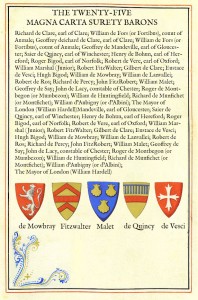
The Epworth Magna Carta 800th Society was founded in the autumn of 2014 with the joint aims of bringing together the local community to celebrate the anniversary of the original version of Magna Carta while at the same time raising awareness of the importance of a man who, among many other things, was an ancestor of two of Henry VIII’s wives.
After the charter was sealed by King John on 15 June 1215, William de Mowbray, lord-and-master of much of our part of Lincolnshire, was one of a committee of twenty-five barons elected by his fellow rebels to ensure the king kept his word. Although in the intervening 800 years it has become a greatly revered piece of history, Magna Carta actually was a failure in 1215 in that civil war was not prevented and, despite King John dying the following year, would continue until the early autumn of 1217.
(click on the image above right to see the names of the twenty-five Magna Carta Surety Barons, according to the Chronica Majora of the monk Matthew Paris of St Albans. It is highly likely that William de Mowbray was not alone in being an ancestor of the unfortunate queens Anne Boleyn and Katherine Howard.)
Our Society was fortunate to be awarded a small Government grant from the Magna Carta Trust, and in February 2015 I attended a networking event in London, appropriately at the Inner Temple, which lies at the very heart of the Nation’s legal system. One of the spin-offs from this was a meeting ten days later with representatives of The Battlefields Trust in Lincoln, the city where Mowbray had been captured in May 1217 while attacking the Castle, held at the time by supporters of the child-king Henry III. Taking a late-evening leisurely stroll back to the hotel, it was thought-provoking to be retracing the steps of Sir William and his fellow rebels, who had fled for their lives down those steep, narrow streets nearly 800 years ago. Facing Lincoln Castle is the outstanding Cathedral, its Norman and medieval glory nowadays accentuated by the miracle of modern floodlighting. It was here that terrified citizens took refuge in 1217, alas to no avail, from the rapacious and murderous intentions of their own king’s army, on what would prove to be a hideously bleak day in the city’s history.
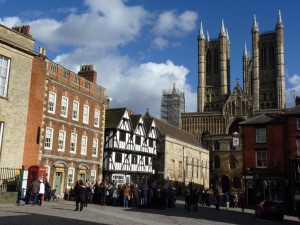
Most of all, though, it was Mowbray’s 10x great-granddaughter, Katherine Howard, who came to mind as we crossed Castle Hill, the ancient thoroughfare linking cathedral and fortress, an area of the city that saw one of the few triumphs of her short reign, while on the Northern progress with her husband. If only those old buildings and streets could talk! The splendour of Queen Katherine’s apparel as she entered the Cathedral by the Great West Door, and the fear and trepidation Henry VIII struck into the hearts of the local nobility and clergy in the summer of 1541 are well documented. So too are Katherine’s stolen hours with her husband’s trusted servant, Thomas Culpeper. At first sight the remarkable carvings around the main entrance to Lincoln Cathedral and along the Norman friezes appear to be purely ornamental, but in actual fact their real message would have been understood by all: Hell and damnation await those who misbehave – and it certainly won’t be pleasant! Did Katherine, one wonders, catch a glimpse of the plight of the tortured souls depicted screaming in the Jaws of Hell? Probably not.
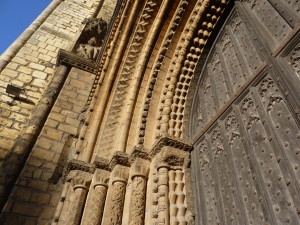
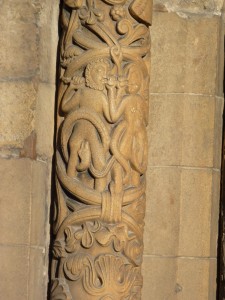
In November 1541 a Grand Jury summoned to meet at Lincoln Castle found Queen Katherine guilty of adultery with Culpeper. Within six months her summer triumph was forgotten and her reputation in shreds as her headless body was hurriedly laid to rest in the Tower of London near that of her similarly mutilated predecessor and first cousin, Anne Boleyn.
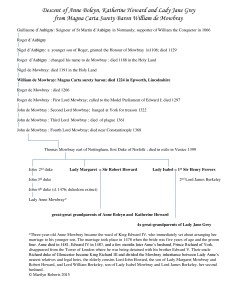
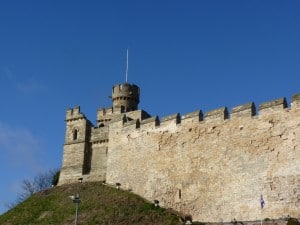
Magna Carta is still seen as a defence against tyranny, and, despite their unpretentious appearance, the four surviving copies of the 1215 original remain amongst the most famous documents in the world. The town of Epworth is justly proud of its connections with these iconic pieces of history and we would like to take this opportunity to invite you to celebrate with us in May and June. The Mowbray Fair is on at Epworth Old Rectory Croft on Sunday 30th May (click on poster below) and then there is a programme of Magna Carta inspired events from Wednesday 3rd June to Sunday 7th June (details to follow).
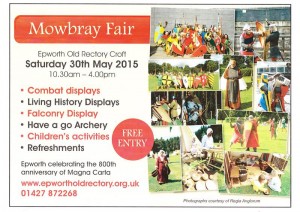
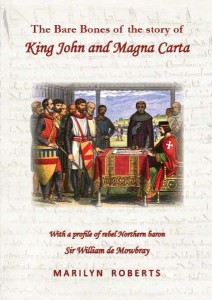 The Bare Bones of the story of King John and Magna Carta: with a profile of rebel Northern baron Sir William de Mowbray is a short book based on the lecture King John, Magna Carta and William de Mowbray to be given by Marilyn Roberts at St Andrew’s Church, Epworth, on Friday 5th June at 3pm – repeated at 7pm – as part of the Epworth Magna Carta 800th celebrations. For further details about the book and more information on the Mowbray family in general see www.queens-haven.co.uk.
The Bare Bones of the story of King John and Magna Carta: with a profile of rebel Northern baron Sir William de Mowbray is a short book based on the lecture King John, Magna Carta and William de Mowbray to be given by Marilyn Roberts at St Andrew’s Church, Epworth, on Friday 5th June at 3pm – repeated at 7pm – as part of the Epworth Magna Carta 800th celebrations. For further details about the book and more information on the Mowbray family in general see www.queens-haven.co.uk.
Marilyn Roberts is a freelance lecturer and writer and is author of The Mowbray Legacy; Lady Anne Mowbray – the High and Excellent Princess; British Royal Family Trees; and The Bare Bones of Queen Victoria’s Family Trees. She is currently working on a book on Katherine Howard and her step-grandmother, the Dowager Duchess of Norfolk. You can find out more about Marilyn and her work at www.queens-haven.co.uk.
References
- Letters and Papers of Henry VIII Vols. XVI and XVII
- The Northerners by J. C. Holt
- The Mowbray Legacy by Marilyn Roberts
- The Bare Bones of the Story of King John and Magna Carta by Marilyn Roberts
- Magna Carta and associated documents can be seen on the British Library website